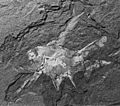Lagerstätte facts for kids
A Lagerstätte (pronounced Lah-ger-shta-teh) is a special place where amazing fossils are found. It's a German word that means "storage place." These sites are unique because they have exceptionally well-preserved fossils, sometimes even showing soft body parts!
In 1970, a scientist named Adolf Seilacher started using this term. He used it to describe places like Solnhofen in Germany, where incredible fossils were discovered.
The most special Lagerstätten are called Konservat-Lagerstätten. These are places where even tiny details of ancient life are preserved. At these sites, skeletons are often found with all their bones still connected, just like they were in life. Even soft parts, like skin or organs, can be preserved as impressions or casts in the rock.
Contents
How Fossils Are Preserved in Lagerstätten
In Lagerstätten, the usual ways that dead animals and plants decay are slowed down or stopped. This happens when sediment (like mud or sand) quickly covers them. This allows soft parts and tiny details to be preserved as fossils.
Here are some reasons why this amazing preservation happens:
- No Oxygen: Sometimes, there's no oxygen in the mud or water. This is called anoxic (an-OX-ik) conditions. Without oxygen, most bacteria that cause decay can't survive. This gives enough time for the soft parts to leave an imprint before they rot away.
- Quick Burial by Ash: If a nearby volcano erupts, volcanic ash can quickly bury dead animals. This stops scavengers (animals that eat dead things) and burrowing animals from reaching the body. It also creates a low-oxygen environment.
- Fast Mudslides: Rapid burial by mudslides can also protect bodies from decay and scavengers.
- Salty Water: Some places have very salty water. Few organisms can live in such salty conditions. This was the case in the lagoons where the Solnhofen limestone formed. The high salt content helped preserve the fossils.
When these special conditions happen, scavengers, burrowing animals, and bacteria are either gone or greatly reduced. This allows the normal process of fossilization to create strata (layers of rock) with incredibly detailed fossils.
What We Learn from Lagerstätten
Most of what we know about the tiny details of ancient life comes from these amazing fossil sites. For example:
- The soft-bodied creatures from the Ediacaran biota (some of the earliest complex life).
- The shape of fins on ichthyosaurs (ancient marine reptiles).
- The fur and wing structure of pterosaurs (flying reptiles).
- The feathers on Mesozoic dinosaurs and early birds.
All these discoveries were made thanks to fossils from Lagerstätten. These sites preserve much of the fauna (animals) and flora (plants) from a specific time and place. This helps scientists understand the ecology (how living things interact with each other and their environment) of ancient Earth.
Famous Lagerstätten Sites
There are about 50 sites around the world known as Lagerstätten. Here are a few famous ones:
- Ediacaran Period: Mistaken Point Ecological Reserve, Newfoundland, Quebec
- Cambrian Period: Sirius Passet, Greenland; Burgess Shale, British Columbia, Canada; Qingjiang biota, Hubei, China
- Ordovician Period: Fezouata Formation, Morocco
- Devonian Period: Rhynie chert, Aberdeen, Scotland
- Carboniferous Period: Mazon Creek, Illinois; Joggins Fossil Cliffs, Nova Scotia
- Upper Jurassic Period: Morrison Formation, western U.S.A.; Solnhofen limestone, Bavaria, Germany
- Lower Cretaceous Period: Jehol biota: Yixian and Jiufotang formations, China.
- Upper Cretaceous Period: Burmese amber fossils; Smoky Hill Chalk; Zhucheng dinosaur site
- Eocene Epoch: Messel Pit, Germany; Green River Formation, Utah.
- Oligocene/Miocene Epochs: Riversleigh, Australia
- Pleistocene Epoch: Rancho La Brea tar pits, Los Angeles, California.
Images for kids
-
Diplomystus dentatus from the Green River Formation, an Eocene Lagerstätte
-
Marrella, the most common Burgess Shale organism
-
Fossil fish from the Green River Formation, an Eocene Lagerstätte
-
Diplacanthus acus, an exceptionally well preserved acanthodian fish (10 cm long) from the Late Devonian Waterloo Farm lagerstätte in the Eastern Cape, South Africa
-
Stranded scyphozoans with the trackways Climactichnites from Blackberry Hill, Wisconsin (Cambrian). Scyphozoan in foreground is 10 cm (3.9 in) in diameter. Slab is in hyporelief.
See also
 In Spanish: Lagerstätte para niños
In Spanish: Lagerstätte para niños






